Medication Administration in Social Care Settings: A BUPA Analysis
VerifiedAdded on 2020/07/23
|8
|2124
|47
Report
AI Summary
This report delves into the critical aspects of medication management within the social care sector, using BUPA as a case study. It begins by outlining current legislation and policies, such as the Medicines Act 1968 and the Health Act 2006, which govern medication practices. The report then identifies the responsibilities and roles of various individuals involved, including care employees, registered managers, nurses, and pharmacists. It explains how medication information, like MAR sheets and care plans, is accessed and details various administration routes and medicine forms. Furthermore, it discusses methods assisting medication management, such as spacer devices and nebulisers. The report also covers data recording, safe storage, and disposal of unused medications, highlighting the importance of regulations like the Control of Substances Hazardous to Health and dangerous waste regulations. The conclusion emphasizes the significance of these practices for patient safety and effective healthcare delivery.
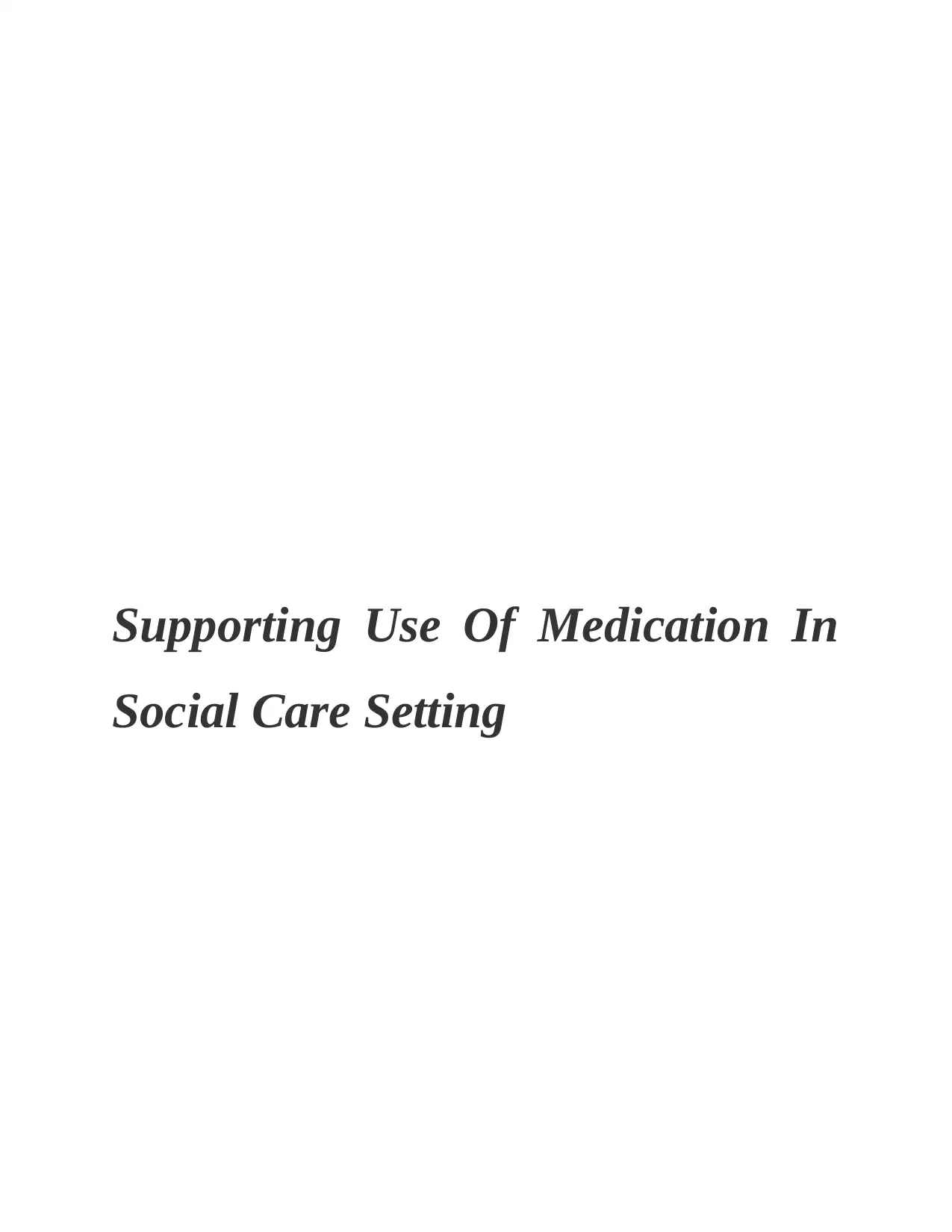
Supporting Use Of Medication In
Social Care Setting
Social Care Setting
Paraphrase This Document
Need a fresh take? Get an instant paraphrase of this document with our AI Paraphraser
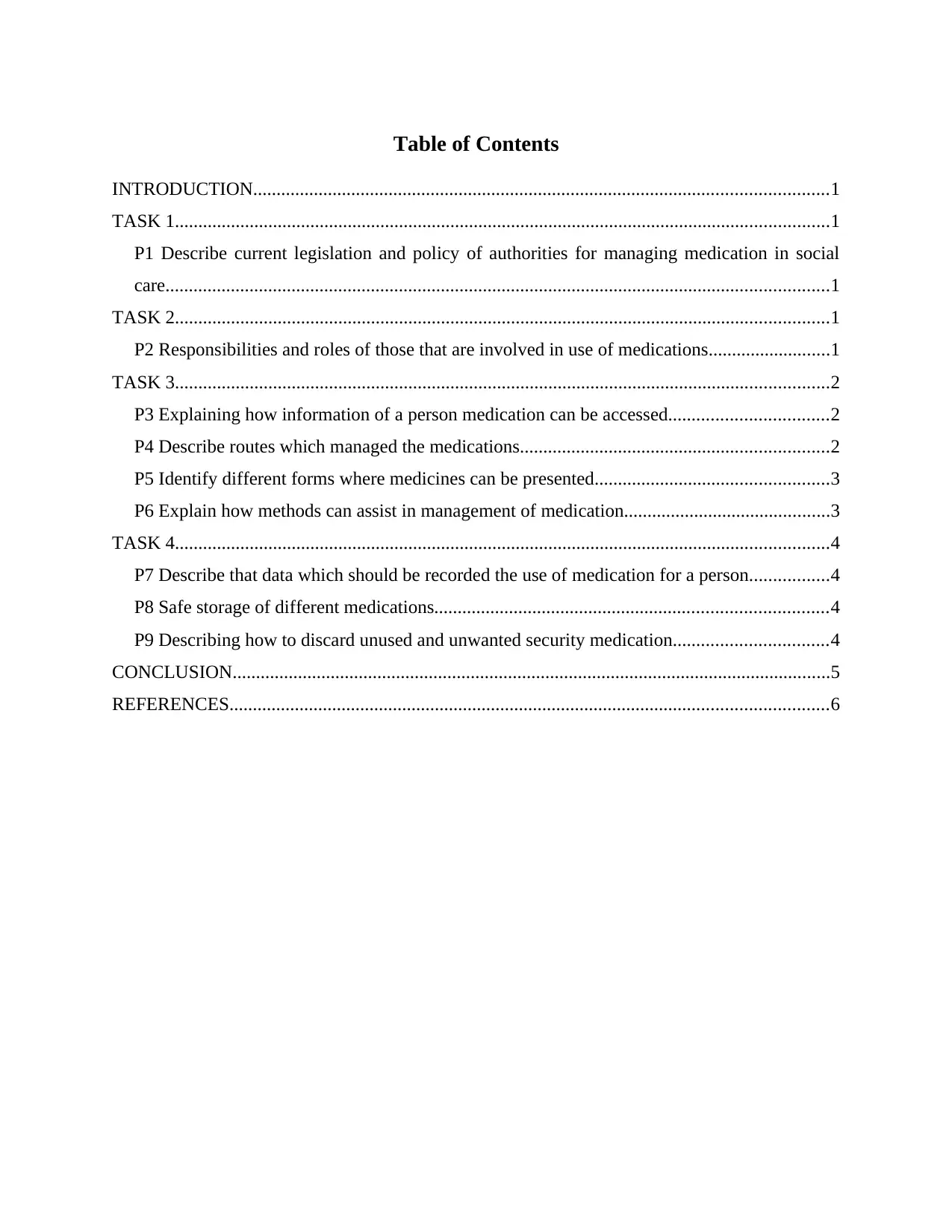
Table of Contents
INTRODUCTION...........................................................................................................................1
TASK 1............................................................................................................................................1
P1 Describe current legislation and policy of authorities for managing medication in social
care..............................................................................................................................................1
TASK 2............................................................................................................................................1
P2 Responsibilities and roles of those that are involved in use of medications..........................1
TASK 3............................................................................................................................................2
P3 Explaining how information of a person medication can be accessed..................................2
P4 Describe routes which managed the medications..................................................................2
P5 Identify different forms where medicines can be presented..................................................3
P6 Explain how methods can assist in management of medication............................................3
TASK 4............................................................................................................................................4
P7 Describe that data which should be recorded the use of medication for a person.................4
P8 Safe storage of different medications....................................................................................4
P9 Describing how to discard unused and unwanted security medication.................................4
CONCLUSION................................................................................................................................5
REFERENCES................................................................................................................................6
INTRODUCTION...........................................................................................................................1
TASK 1............................................................................................................................................1
P1 Describe current legislation and policy of authorities for managing medication in social
care..............................................................................................................................................1
TASK 2............................................................................................................................................1
P2 Responsibilities and roles of those that are involved in use of medications..........................1
TASK 3............................................................................................................................................2
P3 Explaining how information of a person medication can be accessed..................................2
P4 Describe routes which managed the medications..................................................................2
P5 Identify different forms where medicines can be presented..................................................3
P6 Explain how methods can assist in management of medication............................................3
TASK 4............................................................................................................................................4
P7 Describe that data which should be recorded the use of medication for a person.................4
P8 Safe storage of different medications....................................................................................4
P9 Describing how to discard unused and unwanted security medication.................................4
CONCLUSION................................................................................................................................5
REFERENCES................................................................................................................................6
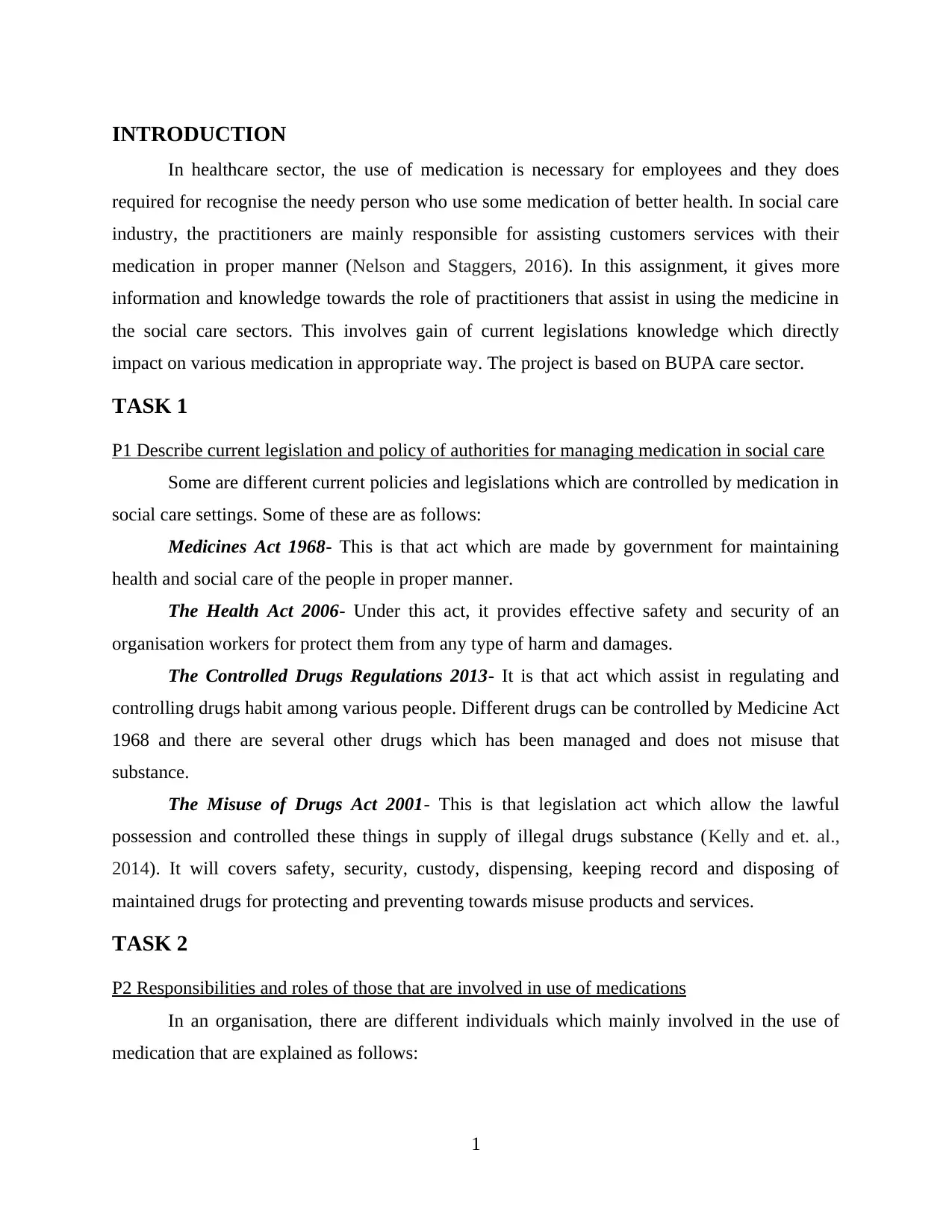
INTRODUCTION
In healthcare sector, the use of medication is necessary for employees and they does
required for recognise the needy person who use some medication of better health. In social care
industry, the practitioners are mainly responsible for assisting customers services with their
medication in proper manner (Nelson and Staggers, 2016). In this assignment, it gives more
information and knowledge towards the role of practitioners that assist in using the medicine in
the social care sectors. This involves gain of current legislations knowledge which directly
impact on various medication in appropriate way. The project is based on BUPA care sector.
TASK 1
P1 Describe current legislation and policy of authorities for managing medication in social care
Some are different current policies and legislations which are controlled by medication in
social care settings. Some of these are as follows:
Medicines Act 1968- This is that act which are made by government for maintaining
health and social care of the people in proper manner.
The Health Act 2006- Under this act, it provides effective safety and security of an
organisation workers for protect them from any type of harm and damages.
The Controlled Drugs Regulations 2013- It is that act which assist in regulating and
controlling drugs habit among various people. Different drugs can be controlled by Medicine Act
1968 and there are several other drugs which has been managed and does not misuse that
substance.
The Misuse of Drugs Act 2001- This is that legislation act which allow the lawful
possession and controlled these things in supply of illegal drugs substance (Kelly and et. al.,
2014). It will covers safety, security, custody, dispensing, keeping record and disposing of
maintained drugs for protecting and preventing towards misuse products and services.
TASK 2
P2 Responsibilities and roles of those that are involved in use of medications
In an organisation, there are different individuals which mainly involved in the use of
medication that are explained as follows:
1
In healthcare sector, the use of medication is necessary for employees and they does
required for recognise the needy person who use some medication of better health. In social care
industry, the practitioners are mainly responsible for assisting customers services with their
medication in proper manner (Nelson and Staggers, 2016). In this assignment, it gives more
information and knowledge towards the role of practitioners that assist in using the medicine in
the social care sectors. This involves gain of current legislations knowledge which directly
impact on various medication in appropriate way. The project is based on BUPA care sector.
TASK 1
P1 Describe current legislation and policy of authorities for managing medication in social care
Some are different current policies and legislations which are controlled by medication in
social care settings. Some of these are as follows:
Medicines Act 1968- This is that act which are made by government for maintaining
health and social care of the people in proper manner.
The Health Act 2006- Under this act, it provides effective safety and security of an
organisation workers for protect them from any type of harm and damages.
The Controlled Drugs Regulations 2013- It is that act which assist in regulating and
controlling drugs habit among various people. Different drugs can be controlled by Medicine Act
1968 and there are several other drugs which has been managed and does not misuse that
substance.
The Misuse of Drugs Act 2001- This is that legislation act which allow the lawful
possession and controlled these things in supply of illegal drugs substance (Kelly and et. al.,
2014). It will covers safety, security, custody, dispensing, keeping record and disposing of
maintained drugs for protecting and preventing towards misuse products and services.
TASK 2
P2 Responsibilities and roles of those that are involved in use of medications
In an organisation, there are different individuals which mainly involved in the use of
medication that are explained as follows:
1
⊘ This is a preview!⊘
Do you want full access?
Subscribe today to unlock all pages.

Trusted by 1+ million students worldwide
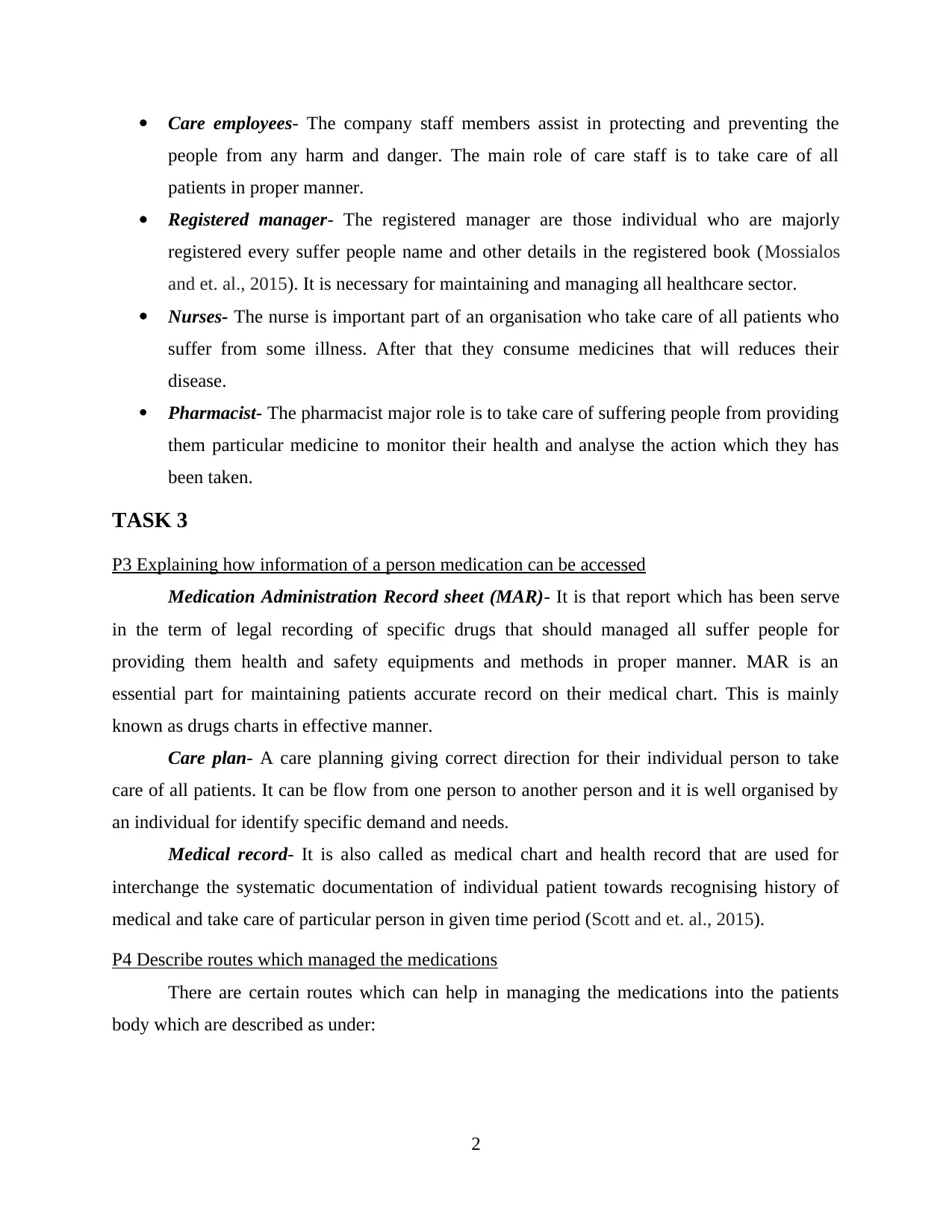
Care employees- The company staff members assist in protecting and preventing the
people from any harm and danger. The main role of care staff is to take care of all
patients in proper manner.
Registered manager- The registered manager are those individual who are majorly
registered every suffer people name and other details in the registered book (Mossialos
and et. al., 2015). It is necessary for maintaining and managing all healthcare sector.
Nurses- The nurse is important part of an organisation who take care of all patients who
suffer from some illness. After that they consume medicines that will reduces their
disease.
Pharmacist- The pharmacist major role is to take care of suffering people from providing
them particular medicine to monitor their health and analyse the action which they has
been taken.
TASK 3
P3 Explaining how information of a person medication can be accessed
Medication Administration Record sheet (MAR)- It is that report which has been serve
in the term of legal recording of specific drugs that should managed all suffer people for
providing them health and safety equipments and methods in proper manner. MAR is an
essential part for maintaining patients accurate record on their medical chart. This is mainly
known as drugs charts in effective manner.
Care plan- A care planning giving correct direction for their individual person to take
care of all patients. It can be flow from one person to another person and it is well organised by
an individual for identify specific demand and needs.
Medical record- It is also called as medical chart and health record that are used for
interchange the systematic documentation of individual patient towards recognising history of
medical and take care of particular person in given time period (Scott and et. al., 2015).
P4 Describe routes which managed the medications
There are certain routes which can help in managing the medications into the patients
body which are described as under:
2
people from any harm and danger. The main role of care staff is to take care of all
patients in proper manner.
Registered manager- The registered manager are those individual who are majorly
registered every suffer people name and other details in the registered book (Mossialos
and et. al., 2015). It is necessary for maintaining and managing all healthcare sector.
Nurses- The nurse is important part of an organisation who take care of all patients who
suffer from some illness. After that they consume medicines that will reduces their
disease.
Pharmacist- The pharmacist major role is to take care of suffering people from providing
them particular medicine to monitor their health and analyse the action which they has
been taken.
TASK 3
P3 Explaining how information of a person medication can be accessed
Medication Administration Record sheet (MAR)- It is that report which has been serve
in the term of legal recording of specific drugs that should managed all suffer people for
providing them health and safety equipments and methods in proper manner. MAR is an
essential part for maintaining patients accurate record on their medical chart. This is mainly
known as drugs charts in effective manner.
Care plan- A care planning giving correct direction for their individual person to take
care of all patients. It can be flow from one person to another person and it is well organised by
an individual for identify specific demand and needs.
Medical record- It is also called as medical chart and health record that are used for
interchange the systematic documentation of individual patient towards recognising history of
medical and take care of particular person in given time period (Scott and et. al., 2015).
P4 Describe routes which managed the medications
There are certain routes which can help in managing the medications into the patients
body which are described as under:
2
Paraphrase This Document
Need a fresh take? Get an instant paraphrase of this document with our AI Paraphraser
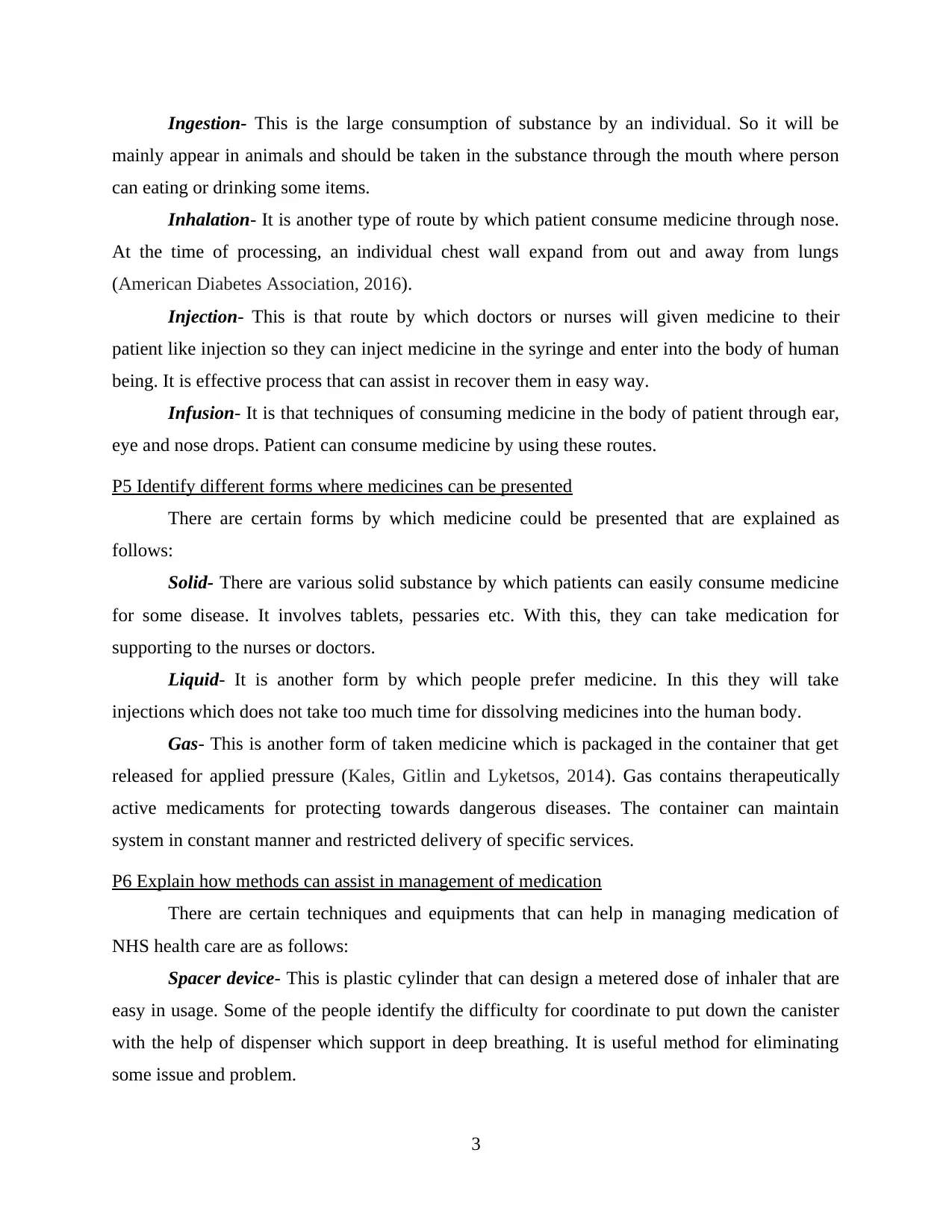
Ingestion- This is the large consumption of substance by an individual. So it will be
mainly appear in animals and should be taken in the substance through the mouth where person
can eating or drinking some items.
Inhalation- It is another type of route by which patient consume medicine through nose.
At the time of processing, an individual chest wall expand from out and away from lungs
(American Diabetes Association, 2016).
Injection- This is that route by which doctors or nurses will given medicine to their
patient like injection so they can inject medicine in the syringe and enter into the body of human
being. It is effective process that can assist in recover them in easy way.
Infusion- It is that techniques of consuming medicine in the body of patient through ear,
eye and nose drops. Patient can consume medicine by using these routes.
P5 Identify different forms where medicines can be presented
There are certain forms by which medicine could be presented that are explained as
follows:
Solid- There are various solid substance by which patients can easily consume medicine
for some disease. It involves tablets, pessaries etc. With this, they can take medication for
supporting to the nurses or doctors.
Liquid- It is another form by which people prefer medicine. In this they will take
injections which does not take too much time for dissolving medicines into the human body.
Gas- This is another form of taken medicine which is packaged in the container that get
released for applied pressure (Kales, Gitlin and Lyketsos, 2014). Gas contains therapeutically
active medicaments for protecting towards dangerous diseases. The container can maintain
system in constant manner and restricted delivery of specific services.
P6 Explain how methods can assist in management of medication
There are certain techniques and equipments that can help in managing medication of
NHS health care are as follows:
Spacer device- This is plastic cylinder that can design a metered dose of inhaler that are
easy in usage. Some of the people identify the difficulty for coordinate to put down the canister
with the help of dispenser which support in deep breathing. It is useful method for eliminating
some issue and problem.
3
mainly appear in animals and should be taken in the substance through the mouth where person
can eating or drinking some items.
Inhalation- It is another type of route by which patient consume medicine through nose.
At the time of processing, an individual chest wall expand from out and away from lungs
(American Diabetes Association, 2016).
Injection- This is that route by which doctors or nurses will given medicine to their
patient like injection so they can inject medicine in the syringe and enter into the body of human
being. It is effective process that can assist in recover them in easy way.
Infusion- It is that techniques of consuming medicine in the body of patient through ear,
eye and nose drops. Patient can consume medicine by using these routes.
P5 Identify different forms where medicines can be presented
There are certain forms by which medicine could be presented that are explained as
follows:
Solid- There are various solid substance by which patients can easily consume medicine
for some disease. It involves tablets, pessaries etc. With this, they can take medication for
supporting to the nurses or doctors.
Liquid- It is another form by which people prefer medicine. In this they will take
injections which does not take too much time for dissolving medicines into the human body.
Gas- This is another form of taken medicine which is packaged in the container that get
released for applied pressure (Kales, Gitlin and Lyketsos, 2014). Gas contains therapeutically
active medicaments for protecting towards dangerous diseases. The container can maintain
system in constant manner and restricted delivery of specific services.
P6 Explain how methods can assist in management of medication
There are certain techniques and equipments that can help in managing medication of
NHS health care are as follows:
Spacer device- This is plastic cylinder that can design a metered dose of inhaler that are
easy in usage. Some of the people identify the difficulty for coordinate to put down the canister
with the help of dispenser which support in deep breathing. It is useful method for eliminating
some issue and problem.
3
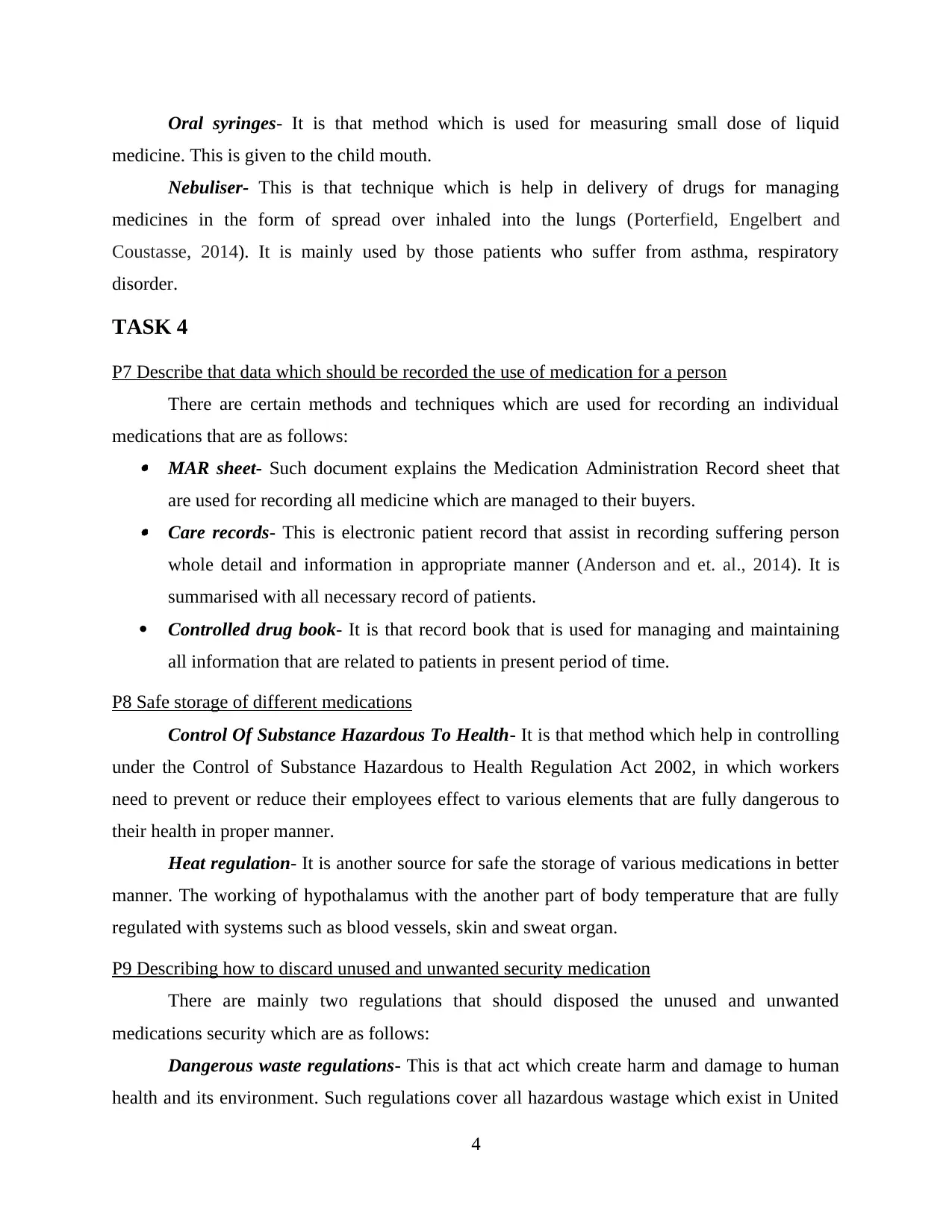
Oral syringes- It is that method which is used for measuring small dose of liquid
medicine. This is given to the child mouth.
Nebuliser- This is that technique which is help in delivery of drugs for managing
medicines in the form of spread over inhaled into the lungs (Porterfield, Engelbert and
Coustasse, 2014). It is mainly used by those patients who suffer from asthma, respiratory
disorder.
TASK 4
P7 Describe that data which should be recorded the use of medication for a person
There are certain methods and techniques which are used for recording an individual
medications that are as follows: MAR sheet- Such document explains the Medication Administration Record sheet that
are used for recording all medicine which are managed to their buyers. Care records- This is electronic patient record that assist in recording suffering person
whole detail and information in appropriate manner (Anderson and et. al., 2014). It is
summarised with all necessary record of patients.
Controlled drug book- It is that record book that is used for managing and maintaining
all information that are related to patients in present period of time.
P8 Safe storage of different medications
Control Of Substance Hazardous To Health- It is that method which help in controlling
under the Control of Substance Hazardous to Health Regulation Act 2002, in which workers
need to prevent or reduce their employees effect to various elements that are fully dangerous to
their health in proper manner.
Heat regulation- It is another source for safe the storage of various medications in better
manner. The working of hypothalamus with the another part of body temperature that are fully
regulated with systems such as blood vessels, skin and sweat organ.
P9 Describing how to discard unused and unwanted security medication
There are mainly two regulations that should disposed the unused and unwanted
medications security which are as follows:
Dangerous waste regulations- This is that act which create harm and damage to human
health and its environment. Such regulations cover all hazardous wastage which exist in United
4
medicine. This is given to the child mouth.
Nebuliser- This is that technique which is help in delivery of drugs for managing
medicines in the form of spread over inhaled into the lungs (Porterfield, Engelbert and
Coustasse, 2014). It is mainly used by those patients who suffer from asthma, respiratory
disorder.
TASK 4
P7 Describe that data which should be recorded the use of medication for a person
There are certain methods and techniques which are used for recording an individual
medications that are as follows: MAR sheet- Such document explains the Medication Administration Record sheet that
are used for recording all medicine which are managed to their buyers. Care records- This is electronic patient record that assist in recording suffering person
whole detail and information in appropriate manner (Anderson and et. al., 2014). It is
summarised with all necessary record of patients.
Controlled drug book- It is that record book that is used for managing and maintaining
all information that are related to patients in present period of time.
P8 Safe storage of different medications
Control Of Substance Hazardous To Health- It is that method which help in controlling
under the Control of Substance Hazardous to Health Regulation Act 2002, in which workers
need to prevent or reduce their employees effect to various elements that are fully dangerous to
their health in proper manner.
Heat regulation- It is another source for safe the storage of various medications in better
manner. The working of hypothalamus with the another part of body temperature that are fully
regulated with systems such as blood vessels, skin and sweat organ.
P9 Describing how to discard unused and unwanted security medication
There are mainly two regulations that should disposed the unused and unwanted
medications security which are as follows:
Dangerous waste regulations- This is that act which create harm and damage to human
health and its environment. Such regulations cover all hazardous wastage which exist in United
4
⊘ This is a preview!⊘
Do you want full access?
Subscribe today to unlock all pages.

Trusted by 1+ million students worldwide
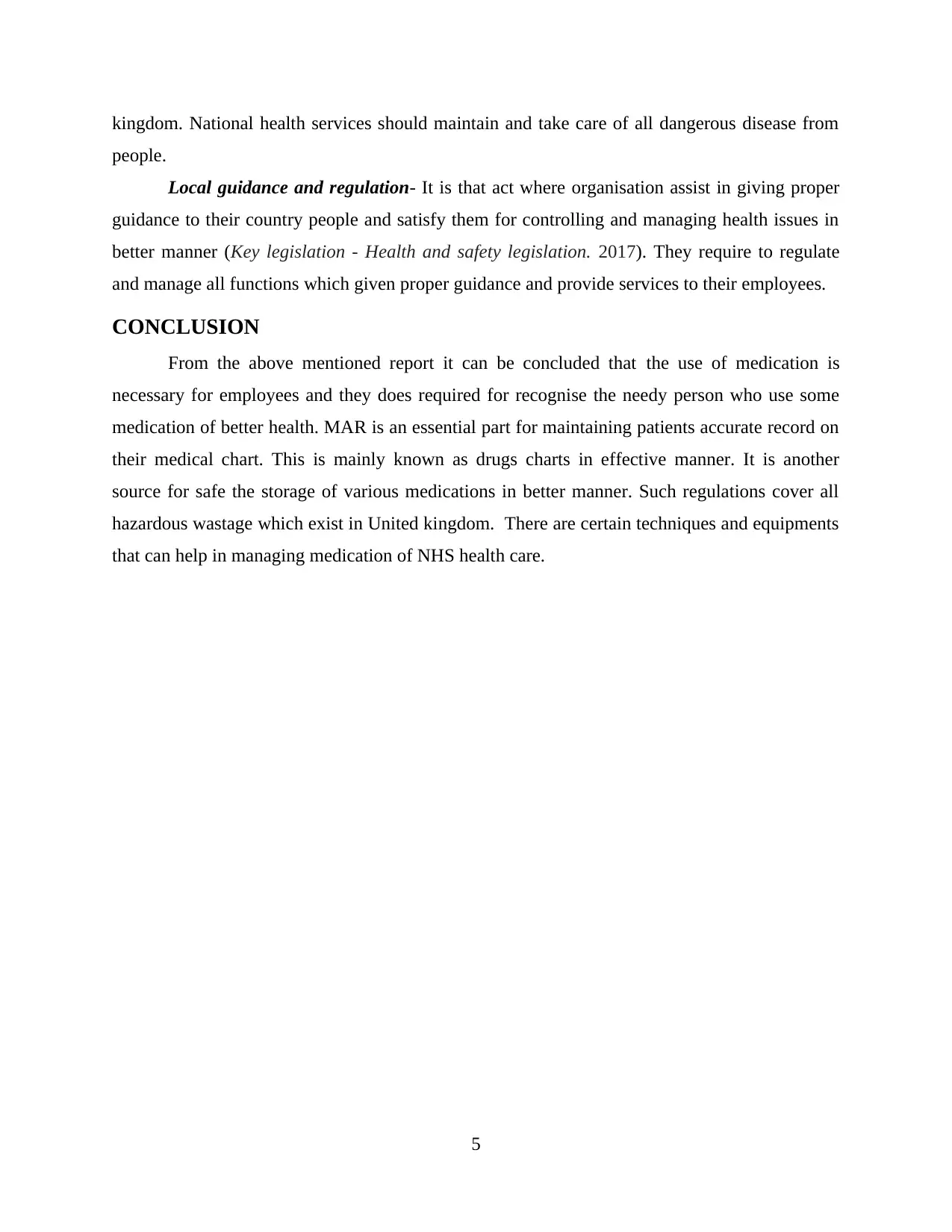
kingdom. National health services should maintain and take care of all dangerous disease from
people.
Local guidance and regulation- It is that act where organisation assist in giving proper
guidance to their country people and satisfy them for controlling and managing health issues in
better manner (Key legislation - Health and safety legislation. 2017). They require to regulate
and manage all functions which given proper guidance and provide services to their employees.
CONCLUSION
From the above mentioned report it can be concluded that the use of medication is
necessary for employees and they does required for recognise the needy person who use some
medication of better health. MAR is an essential part for maintaining patients accurate record on
their medical chart. This is mainly known as drugs charts in effective manner. It is another
source for safe the storage of various medications in better manner. Such regulations cover all
hazardous wastage which exist in United kingdom. There are certain techniques and equipments
that can help in managing medication of NHS health care.
5
people.
Local guidance and regulation- It is that act where organisation assist in giving proper
guidance to their country people and satisfy them for controlling and managing health issues in
better manner (Key legislation - Health and safety legislation. 2017). They require to regulate
and manage all functions which given proper guidance and provide services to their employees.
CONCLUSION
From the above mentioned report it can be concluded that the use of medication is
necessary for employees and they does required for recognise the needy person who use some
medication of better health. MAR is an essential part for maintaining patients accurate record on
their medical chart. This is mainly known as drugs charts in effective manner. It is another
source for safe the storage of various medications in better manner. Such regulations cover all
hazardous wastage which exist in United kingdom. There are certain techniques and equipments
that can help in managing medication of NHS health care.
5
Paraphrase This Document
Need a fresh take? Get an instant paraphrase of this document with our AI Paraphraser
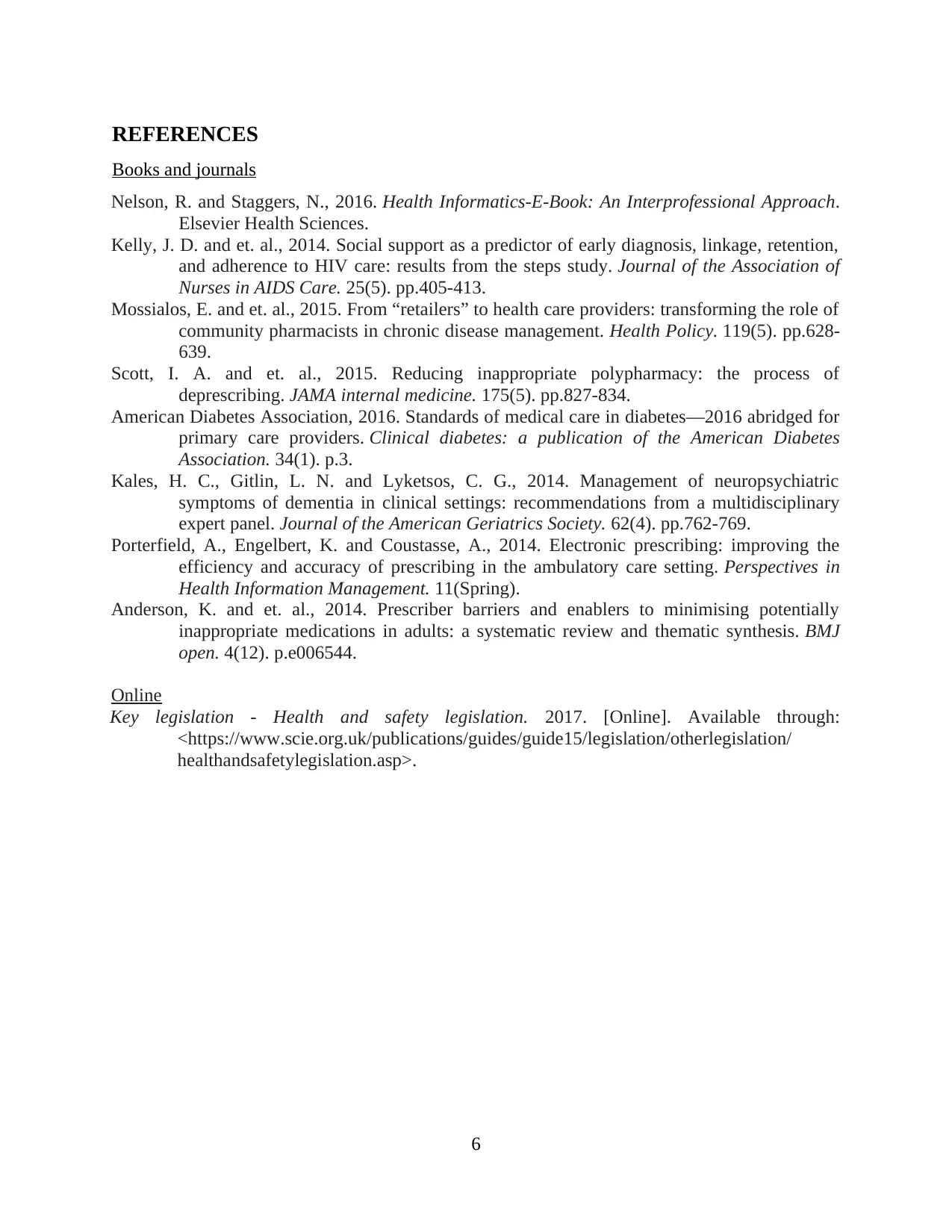
REFERENCES
Books and journals
Nelson, R. and Staggers, N., 2016. Health Informatics-E-Book: An Interprofessional Approach.
Elsevier Health Sciences.
Kelly, J. D. and et. al., 2014. Social support as a predictor of early diagnosis, linkage, retention,
and adherence to HIV care: results from the steps study. Journal of the Association of
Nurses in AIDS Care. 25(5). pp.405-413.
Mossialos, E. and et. al., 2015. From “retailers” to health care providers: transforming the role of
community pharmacists in chronic disease management. Health Policy. 119(5). pp.628-
639.
Scott, I. A. and et. al., 2015. Reducing inappropriate polypharmacy: the process of
deprescribing. JAMA internal medicine. 175(5). pp.827-834.
American Diabetes Association, 2016. Standards of medical care in diabetes—2016 abridged for
primary care providers. Clinical diabetes: a publication of the American Diabetes
Association. 34(1). p.3.
Kales, H. C., Gitlin, L. N. and Lyketsos, C. G., 2014. Management of neuropsychiatric
symptoms of dementia in clinical settings: recommendations from a multidisciplinary
expert panel. Journal of the American Geriatrics Society. 62(4). pp.762-769.
Porterfield, A., Engelbert, K. and Coustasse, A., 2014. Electronic prescribing: improving the
efficiency and accuracy of prescribing in the ambulatory care setting. Perspectives in
Health Information Management. 11(Spring).
Anderson, K. and et. al., 2014. Prescriber barriers and enablers to minimising potentially
inappropriate medications in adults: a systematic review and thematic synthesis. BMJ
open. 4(12). p.e006544.
Online
Key legislation - Health and safety legislation. 2017. [Online]. Available through:
<https://www.scie.org.uk/publications/guides/guide15/legislation/otherlegislation/
healthandsafetylegislation.asp>.
6
Books and journals
Nelson, R. and Staggers, N., 2016. Health Informatics-E-Book: An Interprofessional Approach.
Elsevier Health Sciences.
Kelly, J. D. and et. al., 2014. Social support as a predictor of early diagnosis, linkage, retention,
and adherence to HIV care: results from the steps study. Journal of the Association of
Nurses in AIDS Care. 25(5). pp.405-413.
Mossialos, E. and et. al., 2015. From “retailers” to health care providers: transforming the role of
community pharmacists in chronic disease management. Health Policy. 119(5). pp.628-
639.
Scott, I. A. and et. al., 2015. Reducing inappropriate polypharmacy: the process of
deprescribing. JAMA internal medicine. 175(5). pp.827-834.
American Diabetes Association, 2016. Standards of medical care in diabetes—2016 abridged for
primary care providers. Clinical diabetes: a publication of the American Diabetes
Association. 34(1). p.3.
Kales, H. C., Gitlin, L. N. and Lyketsos, C. G., 2014. Management of neuropsychiatric
symptoms of dementia in clinical settings: recommendations from a multidisciplinary
expert panel. Journal of the American Geriatrics Society. 62(4). pp.762-769.
Porterfield, A., Engelbert, K. and Coustasse, A., 2014. Electronic prescribing: improving the
efficiency and accuracy of prescribing in the ambulatory care setting. Perspectives in
Health Information Management. 11(Spring).
Anderson, K. and et. al., 2014. Prescriber barriers and enablers to minimising potentially
inappropriate medications in adults: a systematic review and thematic synthesis. BMJ
open. 4(12). p.e006544.
Online
Key legislation - Health and safety legislation. 2017. [Online]. Available through:
<https://www.scie.org.uk/publications/guides/guide15/legislation/otherlegislation/
healthandsafetylegislation.asp>.
6
1 out of 8
Related Documents
Your All-in-One AI-Powered Toolkit for Academic Success.
+13062052269
info@desklib.com
Available 24*7 on WhatsApp / Email
![[object Object]](/_next/static/media/star-bottom.7253800d.svg)
Unlock your academic potential
Copyright © 2020–2025 A2Z Services. All Rights Reserved. Developed and managed by ZUCOL.





